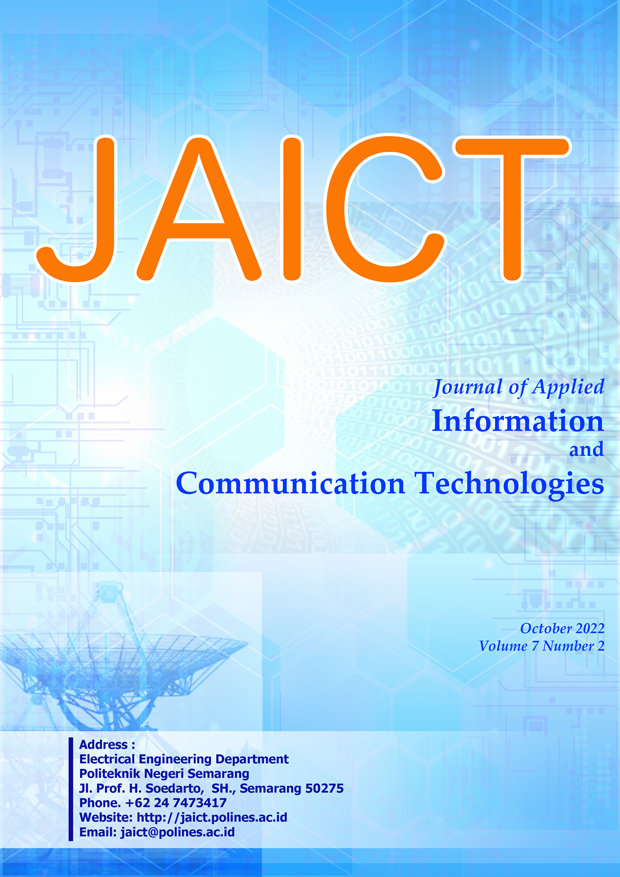Temperature, Humidity, and Power Outage Monitoring System of Pamapersada Nusantara”™s Server Racks
DOI:
https://doi.org/10.32497/jaict.v7i2.3269Keywords:
Data center, IoT, telegram, temperature and humidity monitoringAbstract
Data center is a vital location that must be managed. The room contains central devices that are essential for operational continuity of the information system. Like the PT Pamapersada Nusantara data center, this room needs to be maintained according to standards. One thing that needs to be maintained is temperature, humidity, and electricity because they have a direct impact on IT equipment and can be potentially fatal if they are not in standard conditions. Meanwhile, the data center being researched uses manual checks for temperature, humidity, and electrical power supply. The problem is the inconsistency of the administrator in documenting these parameters and the lack of responsiveness of repairs if an anomaly occurs in the parameter value, because the data is not real time. This research aims to build a monitoring system for monitoring temperature, humidity, and power outage at the PT Pamapersada Nusantara data center which provides direct notifications to administrators. Current similar studies generally do not include the sensor location factor which is essential. The sensor installation is not randomly placed in the room, nor in the hot aisle or in the cold aisle, but in the server rack so that the temperature and humidity truly represent the surroundings of the device as ASHRAE recommend. Referring to ASHRAE, the standard temperature is 18 ° C - 27 ° C while the humidity is 20% - 60%. This research starts from a needs analysis through a survey, followed by equipment design, equipment testing by comparing with manual measuring tools. ESP8266 and DHT22 sensors are used, telegram as system output in the form of notifications. Notifications are sent when the temperature and humidity values are not in standard conditions, they are sent every day at 07.00 and 15.00, and they are sent if there is 5% increasing or decreasing values. The results show that the system successfully sends a notification on telegram when the conditions are met. Tests using comparisons with other measuring instruments also show a deviation of values below 2%. Measurements on the server rack show varying value depending on the occupancy of the rack and its position against the air conditionerReferences
TIA, “Telecommunications Infrastructure Standard for Data Centers TIA-942,” Arlington, 2005.
S. S. Hermawan and R. R. Saedudin, “Design of Cooling and Air Flow System Using NDLC Method Based on TIA-942 Standards in Data Center at CV Media Smart Semarang,” International Journal of Advances in Data and Information Systems, vol. 1, no. 1, pp. 34”“39, Apr. 2020, doi: 10.25008/ijadis.v1i1.179.
L. P. Hewlett-Packard Development Company, “Applying 2011 ASHRAE data center guidelines to HP ProLiant-based facilities,” 2012.
K. Armando, “Monitoring Suhu dan Kelembaban Udara Menggunakan Sensor DHT22 Dengan Sistem IoT (Internet of Things),” Medan, 2019.
E. H. Tanjung, “Implementasi Teknologi ESP8266 dan Gsm Shield untuk Monitoring serta Pengontrol Suhu Udara Berbasis Website Online (Studi Kasus Balittas Malang),” Malang, 2017.
E. B. Raharjo, S. Marwanto, and A. Romadhona, “Rancangan Sistem Monitoring Suhu dan Kelembaban Ruang Server Berbasis Internet of Things,” Jurnal Teknika ATW, vol. 22, pp. 61”“68, Sep. 2019.
S. Saha and A. Majumdar, “Data Centre Temperature Monitoring with ESP8266 Based Wireless Sensor Network and Cloud Based Dashboard with Real Time Alert System,” Devices for Integrated Circuit (DevIC), pp. 307”“310, Mar. 2017.
M. W. Hariyanto, A. H. Hendrawan, and Ritzkal, “Monitoring the Environmental Temperature Using Arduino and Telegram,” Journal of Robotics and Control (JRC), vol. 1, no. 3, pp. 96”“101, May 2020, doi: 10.18196/jrc.1321.
M. Alvan Prastoyo Utomo, A. Aziz, Winarno, and B. Harjito, “Server Room Temperature & Humidity Monitoring Based on Internet of Thing (IoT),” in Journal of Physics: Conference Series, Sep. 2019, vol. 1306, no. 1. doi: 10.1088/1742-6596/1306/1/012030.
Downloads
Published
Issue
Section
License
Authors who publish with this journal agree to the following terms:Authors retain copyright and grant the journal right of first publication with the work simultaneously licensed under a Creative Commons Attribution License that allows others to share the work with an acknowledgement of the work's authorship and initial publication in this journal.
Authors are able to enter into separate, additional contractual arrangements for the non-exclusive distribution of the journal's published version of the work (e.g., post it to an institutional repository or publish it in a book), with an acknowledgement of its initial publication in this journal.
Authors are permitted and encouraged to post their work online (e.g., in institutional repositories or on their website) prior to and during the submission process, as it can lead to productive exchanges, as well as earlier and greater citation of published work (See The Effect of Open Access).






